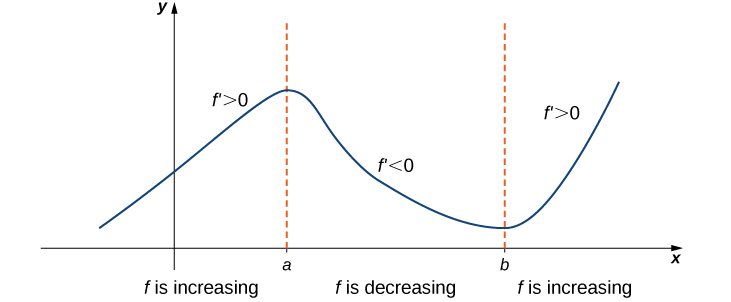Corollaries of the Mean Value Theorem
Let’s now look at three corollaries of the Mean Value Theorem. These results have important consequences, which we use in upcoming sections.
At this point, we know the derivative of any constant function is zero. The Mean Value Theorem allows us to conclude that the converse is also true. In particular, if [latex]f^{\prime}(x)=0[/latex] for all [latex]x[/latex] in some interval [latex]I[/latex], then [latex]f(x)[/latex] is constant over that interval. This result may seem intuitively obvious, but it has important implications that are not obvious, and we discuss them shortly.
Corollary 1: functions with a derivative of zero
Let [latex]f[/latex] be differentiable over an interval [latex]I[/latex]. If [latex]f^{\prime}(x)=0[/latex] for all [latex]x \in I[/latex], then [latex]f(x)[/latex] is constant for all [latex]x \in I[/latex].
Proof
Since [latex]f[/latex] is differentiable over [latex]I[/latex], [latex]f[/latex] must be continuous over [latex]I[/latex]. Suppose [latex]f(x)[/latex] is not constant for all [latex]x[/latex] in [latex]I[/latex]. Then there exist [latex]a,b \in I[/latex], where [latex]a \ne b[/latex] and [latex]f(a) \ne f(b)[/latex]. Choose the notation so that [latex]a Since [latex]f[/latex] is a differentiable function, by the Mean Value Theorem, there exists [latex]c \in (a,b)[/latex] such that Therefore, there exists [latex]c \in I[/latex] such that [latex]f^{\prime}(c) \ne 0[/latex], which contradicts the assumption that [latex]f^{\prime}(x)=0[/latex] for all [latex]x \in I[/latex]. [latex]_\blacksquare[/latex]
From the example above, it follows that if two functions have the same derivative, they differ by, at most, a constant.
Corollary 2: constant difference theorem
If [latex]f[/latex] and [latex]g[/latex] are differentiable over an interval [latex]I[/latex] and [latex]f^{\prime}(x)=g^{\prime}(x)[/latex] for all [latex]x \in I[/latex], then [latex]f(x)=g(x)+C[/latex] for some constant [latex]C[/latex].
Proof
Let [latex]h(x)=f(x)-g(x)[/latex]. Then, [latex]h^{\prime}(x)=f^{\prime}(x)-g^{\prime}(x)=0[/latex] for all [latex]x \in I[/latex]. By Corollary 1, there is a constant [latex]C[/latex] such that [latex]h(x)=C[/latex] for all [latex]x \in I[/latex]. Therefore, [latex]f(x)=g(x)+C[/latex] for all [latex]x \in I[/latex].
[latex]_\blacksquare[/latex]
The third corollary of the Mean Value Theorem discusses when a function is increasing and when it is decreasing.
Recall that a function [latex]f[/latex] is increasing over [latex]I[/latex] if [latex]f(x_1) < f(x_2)[/latex] whenever [latex]x_1 < _2[/latex], whereas [latex]f[/latex] is decreasing over [latex]I[/latex] if [latex]f(x_1) > f(x_2)[/latex] whenever [latex]x_1 < x_2[/latex].
Using the Mean Value Theorem, we can show that if the derivative of a function is positive, then the function is increasing; if the derivative is negative, then the function is decreasing (Figure 9).

This fact is important because it means that for a given function [latex]f[/latex], if there exists a function [latex]F[/latex] such that [latex]F^{\prime}(x)=f(x)[/latex]; then, the only other functions that have a derivative equal to [latex]f[/latex] are [latex]F(x)+C[/latex] for some constant [latex]C[/latex]. We discuss this result in more detail later in the chapter.
Corollary 3: increasing and decreasing functions
Let [latex]f[/latex] be continuous over the closed interval [latex][a,b][/latex] and differentiable over the open interval [latex](a,b)[/latex].
- If [latex]f^{\prime}(x)>0[/latex] for all [latex]x \in (a,b)[/latex], then [latex]f[/latex] is an increasing function over [latex][a,b][/latex].
- If [latex]f^{\prime}(x)<0[/latex] for all [latex]x \in (a,b)[/latex], then [latex]f[/latex] is a decreasing function over [latex][a,b][/latex].
Proof
We will prove 1.; the proof of 2. is similar. Suppose [latex]f[/latex] is not an increasing function on [latex]I[/latex]. Then there exist [latex]a[/latex] and [latex]b[/latex] in [latex]I[/latex] such that [latex]a Since [latex]f(a) \ge f(b)[/latex], we know that [latex]f(b)-f(a) \le 0[/latex]. Also, [latex]a However, [latex]f^{\prime}(x)>0[/latex] for all [latex]x \in I[/latex]. This is a contradiction, and therefore [latex]f[/latex] must be an increasing function over [latex]I[/latex]. [latex]_\blacksquare[/latex]